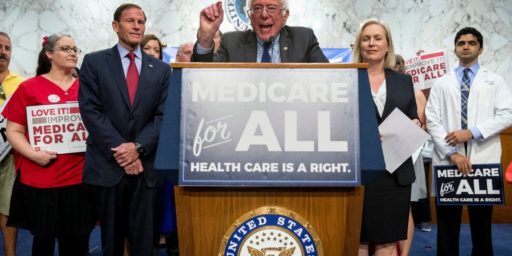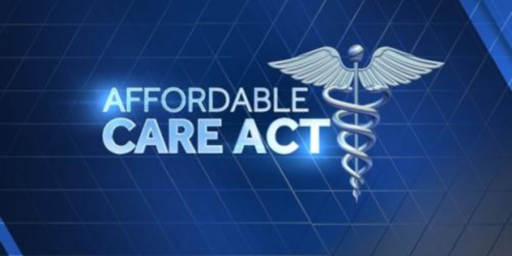The Cautionary Tale of Vermont’s Failed Single-Payer System
Despite seemingly ideal conditions, Green Mountain Care was an absolute debacle.

Amy Goldstein, The Washington Post‘s national health-care policy writer, offers a fascinating look into Green Mountain Care, the revolutionary single-payer system Vermont tried to implement in 2011, and its ultimate failure to launch.
Three and a half years after then-Gov. Peter Shumlin of Vermont signed into law a vision for the nation’s first single-payer health system, his small team was still struggling to find a way to pay for it. With a deadline bearing down, they worked through a frozen, mid-December weekend, trying one computer model Friday night, another Saturday night, yet another Sunday morning.
If they kept going, the governor asked his exhausted team on Monday, could they arrive at a tax plan that would be politically palatable? No, they told him. They could not.
Two days later, on Dec. 17, 2014, Shumlin, a Democrat who had swept into office promising a health-care system that left no one uninsured, announced he was giving up, lamenting the decision as “the greatest disappointment of my political life so far.”
—WaPo, “Why Vermont’s single-payer effort failed and what Democrats can learn from it“
It turns out that “politically palatable” was the key.
Vermont’s foray into publicly financed health care — in a state that in many ways offered the optimal conditions — demonstrates the extraordinary difficulty of trying to convert liberals’ dream of a more just, efficient health system into reality.
Then as now, many of the advocates shared “a belief that borders on the theological” that such a system would save money, as one analyst put it — even though no one knew what it would cost when it passed in Vermont.
That belief would prove naive. The choices Shumlin favored would essentially have doubled Vermont’s budget, raising state income taxes by up to 9.5 percent and placing an 11.5 percent payroll tax on all employers — a burden Shumlin said would pose “a risk of economic shock” — even though Vermonters would no longer pay for private health plans.
The dozens of decisions the governor’s team made in designing the system — what benefits to include, whom to cover and the amount of out-of-pocket costs — required trade-offs with big winners and losers.
In previous posts, I have excused Bernie Sanders and other contenders for the Democratic nomination for talking about Medicare-for-All in aspirational terms. Not only would offering nitty-gritty details be an unreasonable expectation without huge teams of experts to do the research but it would invite opponents to sharp-shoot specifics that would quite likely not even appear in the final legislation, which would have to make it through negotiations in a yet-to-be-elected Congress.
But Green Mountain Care shows the limitations of this. The notion that cost savings or “the rich” will pay for it all is simply a fantasy.
The problem is one that Dave Schuler has talked about for years, both at The Glittering Eye and the late, lamented OTB Radio:
Far and away the biggest hurdles, though, were untamed health-care costs, which were growing faster than the U.S. economy and making care increasingly unaffordable no matter how it was paid for.
“What I learned the hard way,” Shumlin said, “is it isn’t just about reforming the broken payment system. Public financing will not work until you get costs under control.”
There are all manners of doing that, of course, but none of them are popular. Any change to the existing structure will yield howls of protest from patients, physicians, hospitals, or all of the above.
Those building a national single-payer model would confront many of those same dilemmas. But as the 2020 campaigns get underway, few Democrats show signs of acknowledging, let alone wrestling with, the gritty complexities. Even Sanders, eager as he was for Vermont to become the first single-payer state, seldom mentions that it did not come to pass.
“I see no evidence from the Medicare-for-all advocacy community of a serious effort to understand and learn from the lessons from Vermont’s failure,” said John McDonough, who was a senior aide to Sen. Edward M. Kennedy (D-Mass.) and is now a professor at the Harvard T.H. Chan School of Public Health. “Those who ignore history are cursed to repeat it.”
Further, as Goldstein rightly notes, pulling off in Vermont should have been much easier than a national plan:
If any state offered fertile terrain to create a single-payer version of universal health care, Vermont was it.
It has some of the nation’s healthiest residents, with some of the lowest rates of uninsured. It is small and homogeneous. It shares a border with Canada, putting an existing single-payer system within sight. And it has just one main insurer, the nonprofit Blue Cross Blue Shield of Vermont, repeatedly ranked the most efficient Blue Cross Blue Shield plan in the nation.
In a bastion of liberal politics, state lawmakers had flirted with single-payer plans as early as the 1990s. But the grass-roots crusade really took off on May Day of 2009, when more than 1,000 people, toting red signs saying “Healthcare Is a Human Right,” gathered at the gold-domed statehouse for the largest weekday rally at the capitol in Vermont history.
So, why did it fail?
First, it faced some obstacles that a national bill might not:
As with any attempt to dismantle one American health-care system and replace it with another, Green Mountain Care was always going to be a long game. For starters, it would not be until 2017 that any state could get federal permission to change the way it used insurance subsidies created under the ACA.
Shumlin and a top aide traveled to Washington to cajole the Treasury Department and the Department of Health and Human Services to allow Vermont to start sooner. They argued the state should be able to take the tax advantages available to employers that offer health benefits and count that money toward public financing.The requests were rejected because they were premature or not allowed under what the federal health-care law and tax law permitted, recalled Jason Levitis, a Treasury Department official at the time specializing in the ACA.
Why the Obama Treasury Department was so obstinate is unclear, given that single-payer would surely have been President Obama’s preferred policy had he thought it politically feasible.
But the larger problem was the details themselves:
Act 48 was 141 pages — far more specific than any plans from Democrats now running for president or Senate legislation Sanders recently reintroduced. Still, it left scores of knotty decisions for Shumlin’s administration.
“It’s easy to write a bill saying we are going to cover everybody,” said a member of his staff who worked on the plan and spoke on the condition of anonymity to avoid a professional conflict. “It’s much harder to figure out . . . what exactly your benefit coverage will be [and] are you going to have co-payments.”
It turned out to be complicated by strange forces, both internal and external:
On the fifth floor of the Pavilion, the governor’s office building, the small team of Shumlin’s staffers divided the tasks. Under the law, the deadline to present a financing plan to state lawmakers was January 2013 — just as the state was creating the machinery for its ACA insurance marketplace.
“Its political timing couldn’t be worse,” Shumlin recalled. Like a number of states that created their own insurance exchanges, Vermont’s online marketplace malfunctioned. “Voters were saying, ‘If this guy can’t get an exchange running, how could we trust him to revamp our entire health-care system?’ ” Shumlin said.
It was nearly two years after he had signed the bill when Shumlin assigned a tax specialist to begin developing Green Mountain Care’s financing.
By then, the governor had been under intense pressure on other decisions. Single-payer advocates and unions pressed hard for generous benefits. In a state with workers coming in from Massachusetts, New Hampshire and New York, some employers argued that their out-of-staters needed to be included.
In the end, Shumlin agreed that businesses should not need to exclude part of their workforce from the system and that it would be unfair to offer benefits less than public employees already had. The plan would have covered, on average, 94 percent of Vermonters’ health-care costs.
Some of these forces would presumably be obviated with a national plan. But there would surely be many other complications from expanding beyond one tiny, homogeneous, progressive-leaning state.
Then again, even progressive states have NIMBY:
Meanwhile, small businesses that did not offer health benefits, such as Vermont’s “creemee stands” selling soft-serve ice cream, feared the specter of higher taxes, recalled Bram Kleppner, a chief executive of a pewter company who supports single-payer and was on a Shumlin business advisory council. “We never figured out the creemee stand — the notion we were going to put all these beloved little businesses run by our cousins and our neighbors out of business by imposing a payroll tax.”
And big companies that were self-insured, such as IBM, resented the prospect of being taxed more to help other Vermonters get coverage.
One would think that single-payer would have obviated the need for IBM to self-insure but, again, this would be different in a national plan than one in a tiny state.
Regardless, it turned out to be too darned expensive:
Consultants had said that the amount Vermonters and their employers were paying in insurance premiums and patients’ out-of-pocket costs was more than what would be needed in additional tax revenue. But the prediction that Vermont’s overall health spending would decrease, while more people got coverage, was unproven — and, in any case, was a hard sell in the face of big new taxes.
Shumlin’s team developed 14 alternative financing concepts, according to the governor’s former staffer. “The pressure on us was to see if we could get the payroll tax under double digits, which we couldn’t figure out how to do without making the income tax” on individuals too high, that staffer said.
The governor promised to announce the financing soon after the 2014 elections. With liberals fearing he was losing political will to launch Green Mountain Care, amid other controversies, Shumlin won a third term over a GOP political neophyte in a contest so close it ended up being decided by the legislature.
By then, the computer runs kept showing that the only way to set taxes at rates as low as they were striving for was to provide skimpier coverage than most insured Vermonters already had.
“As we completed the financing modeling,” Shumlin said at a news conference at which he abandoned his quest, “it became clear that the risk of economic shock is too high at this time to offer a plan I can responsibly support for passage in the legislature.”
Green Mountain Care would have cost $4.3 billion in its first year, with less funding than the state wanted from the federal government and $2.6 billion in new state tax revenue. By 2020, Shumlin’s team estimated, the cost would have swollen to $5 billion.
Critics are mixed in their views of what lesson we should learn:
To some who still bear the battle scars of Green Mountain Care, the state’s unrealized vision is a neon warning for Sanders and other disciples of single-payer health care.
“If you can’t do it in Vermont, with one private health plan and low uninsured rates, then the amount of disruption you would have nationally with winners and losers would be enormous,” said Kenneth Thorpe, an Emory University health-policy researcher who worked as a consultant to Vermont.
Advocates, however, are undeterred.
“Health care is not free,” acknowledged Deb Richter, a family physician who moved to Vermont three decades ago to crusade for single-payer. “There is no Santa Claus.” But, she argued, “there is more than enough money already floating on health care” — it just needs to be removed from the control of private insurance companies, she said.
Shumlin, who has returned to private business, has come to believe it is not that simple. In his last two years in office, he pursued innovations to drive down health-care spending, including an experiment approved by the Obama administration.
After reflecting on what he tried and failed to do, he sometimes thinks a national single-payer effort might be easier to pull off.
But when he listens to the 2020 candidates, their health-care pitches strike him as shallow.“I kind of know why,” he said. “Their job is to try to build support for an idea. I did the same thing when I ran. Listen — changing health-care systems is wonky work.”
Still, he said, “if I were running for president of the United States, I would have a team working on a plan so I don’t sell an idea to Americans that you can’t achieve. That’s the mistake I made.”
The obvious push-back, of course, is that pretty much every civilized country on the planet has somehow managed to pull off some sort of single-payer healthcare system. And I agree that this is a problem that is not only solvable but that must be solved.
At the same time, America’s political culture is not the same as those in Western Europe, Canada, or Japan. We’re much more individualistic, skeptical of Big Government, and exceedingly tax-averse.
Further, the citizens most likely to vote—much less those with the wherewithal to finance political campaigns and lobby Congress—tend to fare rather well under the current system. Most of us have excellent insurance that’s heavily subsidized by our employers and that requires very little additional out-of-pocket expense.
I believe Sanders, Elizabeth Warren, and others whose “plans” are built around expanding Medicare are on the right track. It’s a very popular program even with ostensible small government types. But I strongly suspect that, even if they’re elected and manage to get a substantially more friendly Senate than the current one, we’re likely to see Medicare-for-More rather than Medicare-for-All as the next step in the journey.






“we’re likely to see Medicare-for-More rather than Medicare-for-All as the next step in the journey.”
Yes. The problem lies in the transition. Total spending probably goes down if you simply apply the current Medicare program to everyone, but you see a big shock in taxes (but with health insurance premiums disappearing). That will be easy to demagogue and you would have some people ending up with insurance that is not as generous. However, we know that Medicare is very popular with those who use it. So, I think you could start with Medicare starting at age 62. Maybe also offer it as a public option on the ACA sites. Gradually work the ages down over 10-20 years until it covers everyone.
The risks on the cost side is that the progressives over reach and try to change Medicare and drive up its cost, but if they can avoid changing it too much it could be sellable. That said, there will be a lot of opposition from some providers, big pharma, device makers, insurance companies (duh!), etc.
Steve
@steve:
I would prefer to do it in one fell swoop but think something like this more likely to pass. I could also see working from both ends: Medicare from birth to 18/21 and then 62 to death. Indeed, there’s probably a better argument for covering kids—especially preschoolers—than there is for covering 62-65, which tends to be a wealthy demographic.
I can see the argument for kids, but they sort of have Medicaid (though not so much in pro-life states). I just think that with he older group you have a bunch of people who were going to be on Medicare soon anyway, plus you dont need to change much about Medicare for them. If Medicare is going to cover kids you need to make big changes since it pretty much doesn’t cover them now. I would rather opt for an easier, smoother transition minimizing changes, but them my management style has almost always involved going after the low hanging fruit first.
Steve
@steve: Your incremental approach strikes me as the most likely outcome, presuming a Democratic President emerges from the 2020 election but not a 60-vote Democratic majority in the Senate.
The problem with Medicare-for-More is that a lot of people will see Medicare as a step down from private insurance. It doesn’t cover as much (only 80%) of expense, has no maximum out-of-pocket and has maximums on the number of hospitals days it will cover. Most people have to buy supplemental insurance.
Most have hybrid systems that still allow for private insurance. Germany, for example, has a combined system that requires coverage (mandatory) and private insurance is available. This *has* to be part of the discussion in the U.S., yet it’s the part of the ACA that drove conservatives bonkers.
Medicare for all is a total fantasy until we get costs under control, including prescription drug coverage. I’m very, very skeptical of any Democrat that says “Medicare for all!” without some real policy behind the statement.
As others have noted, a big issue is that going to a single payer plan is ultimately going to involve actual negotiation between the main stakeholders–hospitals, doctors, and pharmaceutical companies–and whoever the single payer is going to be. Heck, not even Medicare is actually single payer anymore. If one structures one’s plan this way–I didn’t because the upfront costs were too high to suit me–one can end up with as many as 4 parties paying–Medicare, private health insurance, private prescription drug insurance, and medical savings account.
“…[E]ven though Vermonters would no longer pay for private health plans.” Correct me if I’m wrong about this, but unless Vermont is unique, most Vermonters already don’t pay for health plans or don’t pay most of the premiums. I recall that there are these things called “corporations” and “businesses” that buy health plans for their employees, and my experience when I did not work for such entities was that, even if I had been able to afford the premiums, I would not have been able to get a health plan because I didn’t belong to a group.
ETA: “I can see the argument for kids, but they sort of have Medicaid (though not so much in pro-life states). [emphasis added]”
Comment: And how ironic is THAT????
State governments need to have a balanced budget, which means that they cannot just load up on debt to pay for the transition costs. This is going to change the options they have to choose from.
Over a period of ten years, the small businesses that didn’t offer health insurance would adjust to rising taxes, but overnight that would be impossible.
@Just nutha ignint cracker:
If I’m remembering correctly, a large part of the impetus to go to single-payer in Vermont was because it DID have a larger-than-average number of people who were either buying individual coverage (and those premiums are INSANE), or were in the small business category, which were seeing double-digit increases. Aside from Ben & Jerry’s (now owned by Unilever I think), King Arthur Flour, and a handful of others, there aren’t that many larger corporations based in Vermont. So, while not necessarily unique, there were reasons behind this push, and an explanation for that statement.
It’s also the reason that Vermont has been at the forefront of states trying to establish retirement savings that would cover individuals and small businesses.
@James Joyner: SCHIP already works something like this (or at least it did pre-ACA). There was a year in which both my husband and I worked for employers that didn’t offer insurance, but we were able to buy into SCHIP for our daughter. Basically, we were buying into Medicaid for children of families above the poverty level, at $20, $45, and $70 a month premium levels, depending on your income.
@Jen: Thanks for the clarification.
@Hal_10000:
Shit, dude, that’s a huge step up from the insurance at my last job, which had all that crap PLUS a $3K annual deductible. All for the bargain price of $500/month.
To be fair to your point, though, it would be a step down from my current insurance, which costs me the same per month but covers 90% (100% of some services) with a decent out-of-pocket max and no maximum on lifetime coverage.
Someone upthread mentioned the hybrid public/private system in Germany, which I have felt for a long time would be a good model for us to adopt. Or some other mix of basic and supplemental, with the supplemental offering options of different levels geared toward different stages of life.
I like my insurance company – United. I get good, quick responses to questions and concerns. And the deductible is lower than the BC/BS plan offered. They also pay for the gym membership. I would like more choices though. Strange that my prescription is cheaper when I pay myself instead of running it through the plan: $4 compared to $15. I don’t want to be handed one plan and being told “that’s it, take or leave it”.
If we really want to get the prices down, either we’re going to have to impose limits on how much a hospital can charge or at least start insisting on transparency on prices rather than people getting told before the operation “we don’t know” and then getting hit over the head later with ridiculously high charges.
If you can buy a bottle of 100 generic aspirin for $1 I don’t see why hospitals should be allowed to charge $27 per aspirin.
Thank you for the thoughtful article.
If we can’t control our inputs, then how can we control our outputs? With nearly 40% of our population obese, 60% overweight, I struggle to understand how any system can insure this body of people in a cost effective way. As Americans, we view health care incorrectly: as something provided to us or for us. In reality, health care should start with us and how we care for ourselves (diet, exercise etc) and be augmented by medical care. If we move towards a more sustainable system, which we should in some way, then a great deal of social pressure would need to come with this group responsibility.
I am in favor of a more universal, non-employor based approach to health insurance, but any financially sustainable system must have a way of managing the behavior of the citizens. Large scale behavioral change akin to how smoking cigarettes went from cool to taboo in decade. Being unhealthy and obese would become even more taboo, because society as a whole is now responsible for funding the individuals negatively contributing lifestyle. Thanks again for the article.